Report: Leadership, Management, and Operational Strategies at M&S
VerifiedAdded on 2020/07/23
|20
|5665
|40
Report
AI Summary
This report examines the crucial roles of managers and leaders in the context of Marks and Spencer, a major retail firm. It delves into the distinct characteristics and responsibilities of leaders and managers, exploring various leadership theories such as situational, trait, path-goal, transactional, and transformational theories, and their applicability within the organization. The report analyzes the roles of leaders and managers in different organizational contexts, including conflict resolution, human resource management, and globalization. Furthermore, it investigates key approaches to operational management and highlights the importance of operational efficiency in achieving business objectives. Finally, the report identifies factors impacting operational management and decision-making processes within the business, evaluating their effects on the wider business environment and community.
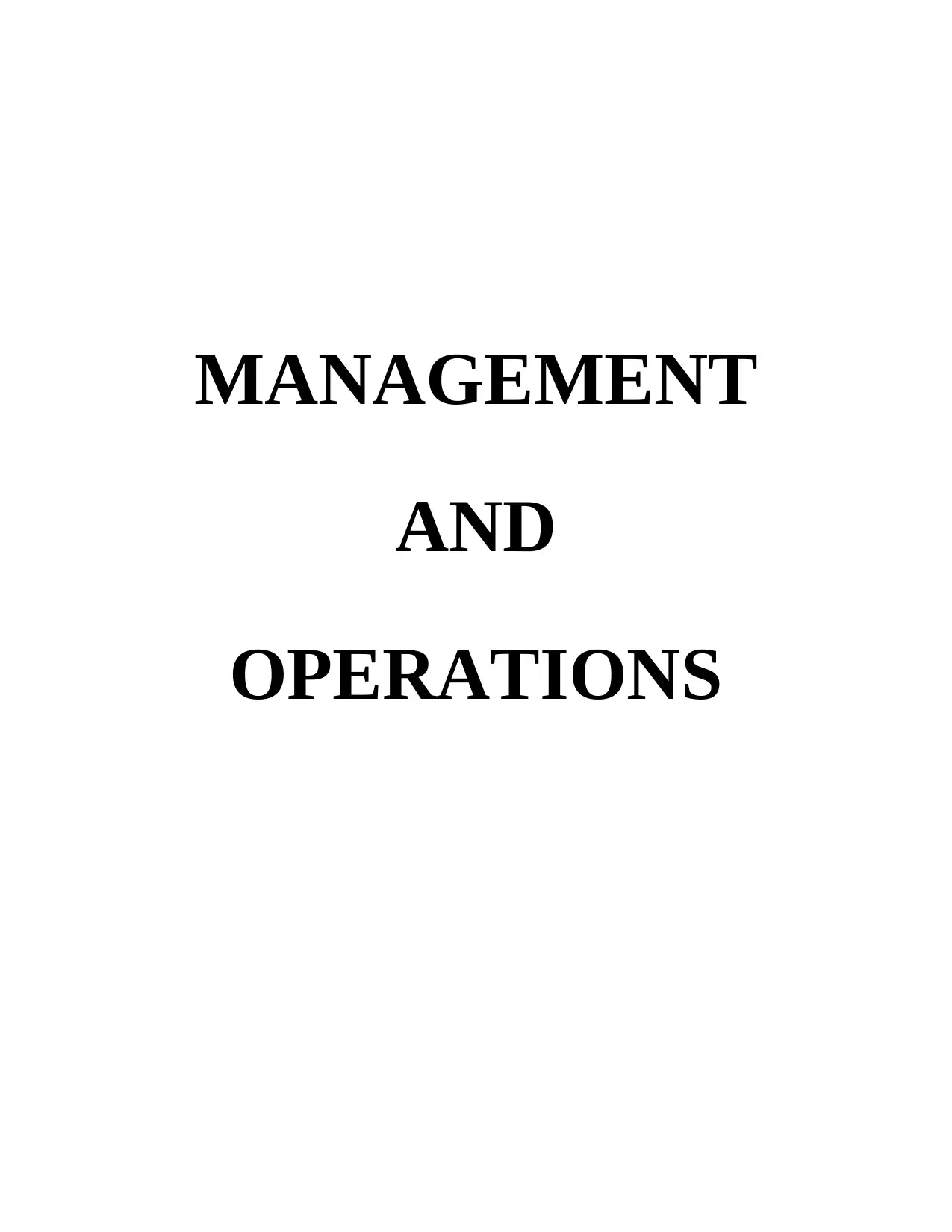
MANAGEMENT
AND
OPERATIONS
AND
OPERATIONS
Paraphrase This Document
Need a fresh take? Get an instant paraphrase of this document with our AI Paraphraser
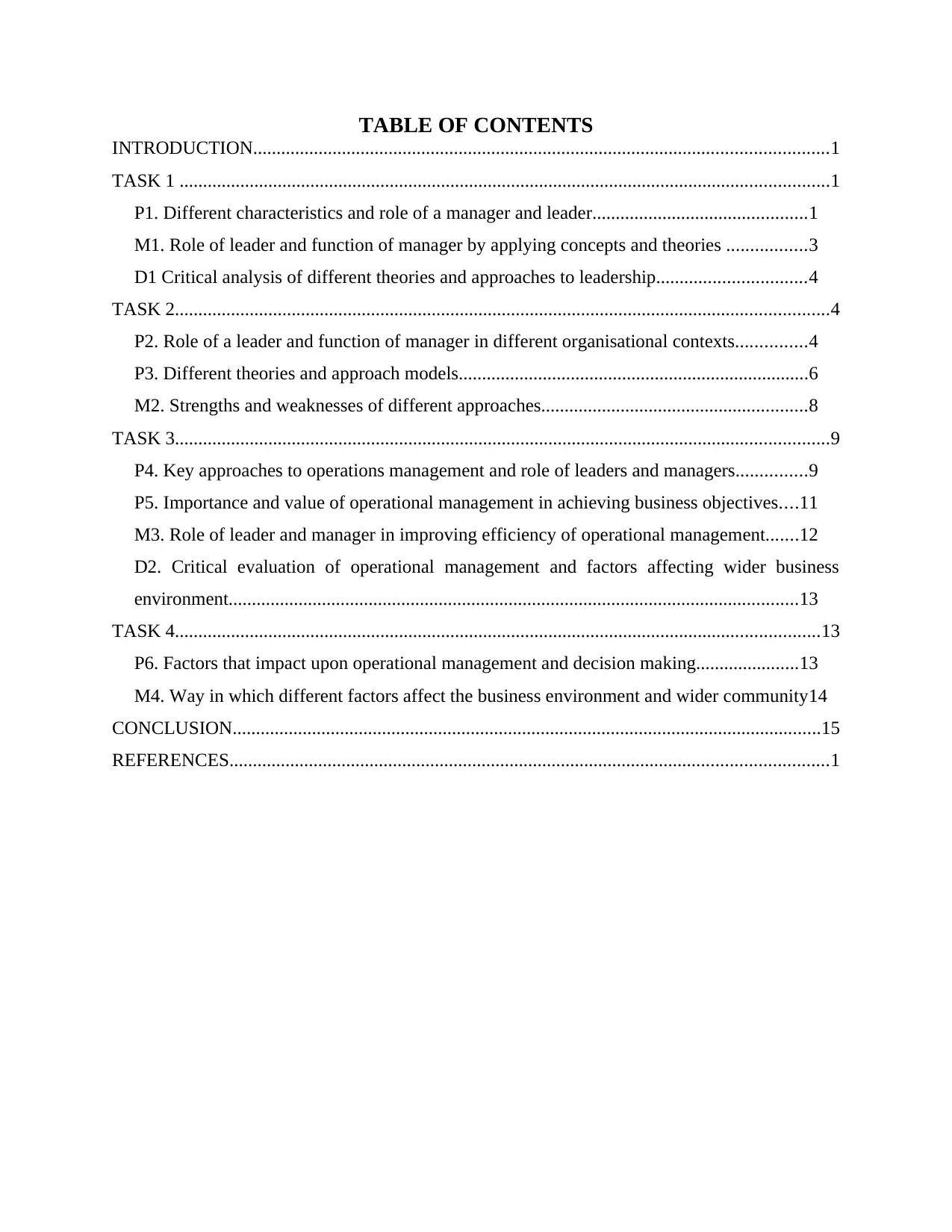
TABLE OF CONTENTS
INTRODUCTION...........................................................................................................................1
TASK 1 ...........................................................................................................................................1
P1. Different characteristics and role of a manager and leader..............................................1
M1. Role of leader and function of manager by applying concepts and theories .................3
D1 Critical analysis of different theories and approaches to leadership................................4
TASK 2............................................................................................................................................4
P2. Role of a leader and function of manager in different organisational contexts...............4
P3. Different theories and approach models...........................................................................6
M2. Strengths and weaknesses of different approaches.........................................................8
TASK 3............................................................................................................................................9
P4. Key approaches to operations management and role of leaders and managers...............9
P5. Importance and value of operational management in achieving business objectives....11
M3. Role of leader and manager in improving efficiency of operational management.......12
D2. Critical evaluation of operational management and factors affecting wider business
environment..........................................................................................................................13
TASK 4..........................................................................................................................................13
P6. Factors that impact upon operational management and decision making......................13
M4. Way in which different factors affect the business environment and wider community14
CONCLUSION..............................................................................................................................15
REFERENCES................................................................................................................................1
INTRODUCTION...........................................................................................................................1
TASK 1 ...........................................................................................................................................1
P1. Different characteristics and role of a manager and leader..............................................1
M1. Role of leader and function of manager by applying concepts and theories .................3
D1 Critical analysis of different theories and approaches to leadership................................4
TASK 2............................................................................................................................................4
P2. Role of a leader and function of manager in different organisational contexts...............4
P3. Different theories and approach models...........................................................................6
M2. Strengths and weaknesses of different approaches.........................................................8
TASK 3............................................................................................................................................9
P4. Key approaches to operations management and role of leaders and managers...............9
P5. Importance and value of operational management in achieving business objectives....11
M3. Role of leader and manager in improving efficiency of operational management.......12
D2. Critical evaluation of operational management and factors affecting wider business
environment..........................................................................................................................13
TASK 4..........................................................................................................................................13
P6. Factors that impact upon operational management and decision making......................13
M4. Way in which different factors affect the business environment and wider community14
CONCLUSION..............................................................................................................................15
REFERENCES................................................................................................................................1

⊘ This is a preview!⊘
Do you want full access?
Subscribe today to unlock all pages.

Trusted by 1+ million students worldwide
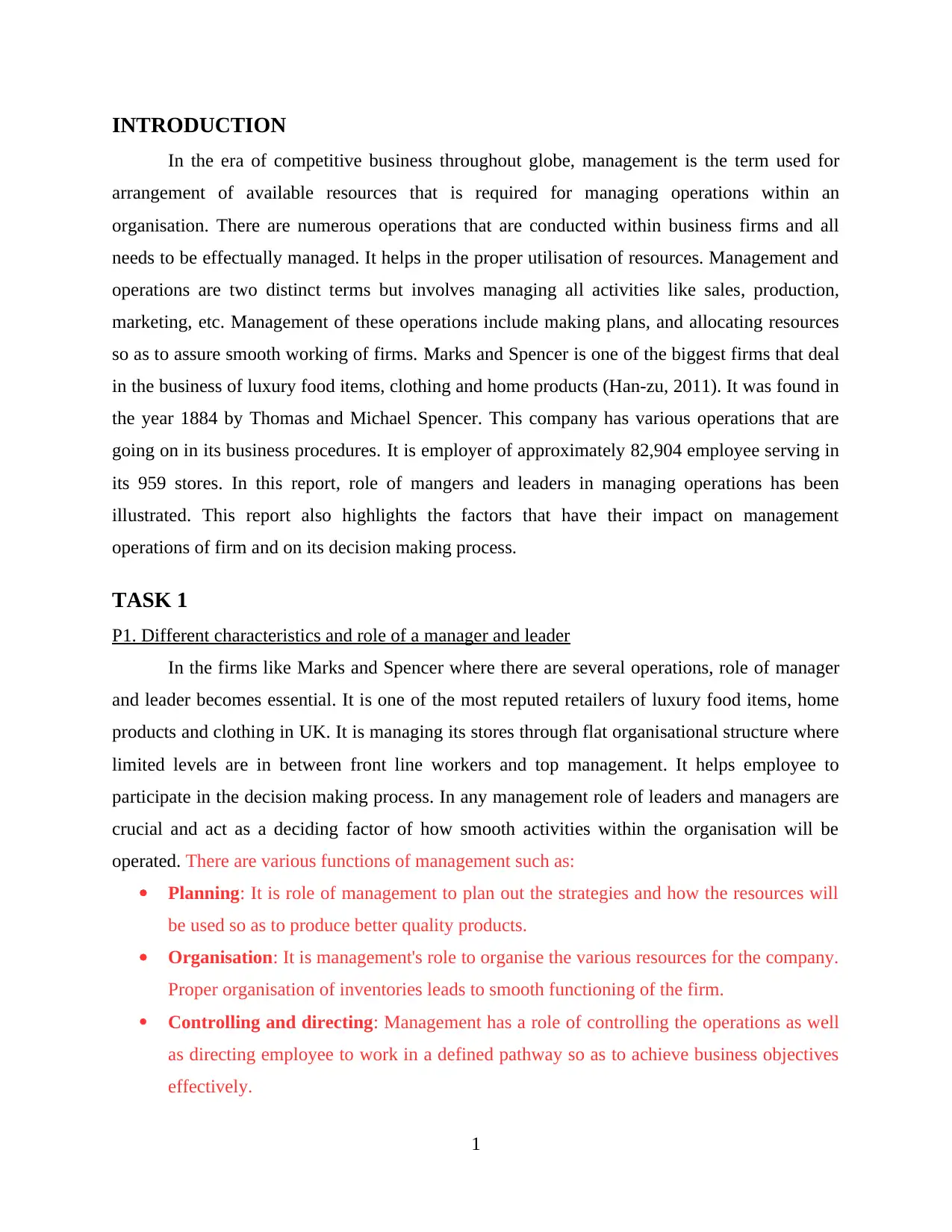
INTRODUCTION
In the era of competitive business throughout globe, management is the term used for
arrangement of available resources that is required for managing operations within an
organisation. There are numerous operations that are conducted within business firms and all
needs to be effectually managed. It helps in the proper utilisation of resources. Management and
operations are two distinct terms but involves managing all activities like sales, production,
marketing, etc. Management of these operations include making plans, and allocating resources
so as to assure smooth working of firms. Marks and Spencer is one of the biggest firms that deal
in the business of luxury food items, clothing and home products (Han-zu, 2011). It was found in
the year 1884 by Thomas and Michael Spencer. This company has various operations that are
going on in its business procedures. It is employer of approximately 82,904 employee serving in
its 959 stores. In this report, role of mangers and leaders in managing operations has been
illustrated. This report also highlights the factors that have their impact on management
operations of firm and on its decision making process.
TASK 1
P1. Different characteristics and role of a manager and leader
In the firms like Marks and Spencer where there are several operations, role of manager
and leader becomes essential. It is one of the most reputed retailers of luxury food items, home
products and clothing in UK. It is managing its stores through flat organisational structure where
limited levels are in between front line workers and top management. It helps employee to
participate in the decision making process. In any management role of leaders and managers are
crucial and act as a deciding factor of how smooth activities within the organisation will be
operated. There are various functions of management such as:
Planning: It is role of management to plan out the strategies and how the resources will
be used so as to produce better quality products.
Organisation: It is management's role to organise the various resources for the company.
Proper organisation of inventories leads to smooth functioning of the firm.
Controlling and directing: Management has a role of controlling the operations as well
as directing employee to work in a defined pathway so as to achieve business objectives
effectively.
1
In the era of competitive business throughout globe, management is the term used for
arrangement of available resources that is required for managing operations within an
organisation. There are numerous operations that are conducted within business firms and all
needs to be effectually managed. It helps in the proper utilisation of resources. Management and
operations are two distinct terms but involves managing all activities like sales, production,
marketing, etc. Management of these operations include making plans, and allocating resources
so as to assure smooth working of firms. Marks and Spencer is one of the biggest firms that deal
in the business of luxury food items, clothing and home products (Han-zu, 2011). It was found in
the year 1884 by Thomas and Michael Spencer. This company has various operations that are
going on in its business procedures. It is employer of approximately 82,904 employee serving in
its 959 stores. In this report, role of mangers and leaders in managing operations has been
illustrated. This report also highlights the factors that have their impact on management
operations of firm and on its decision making process.
TASK 1
P1. Different characteristics and role of a manager and leader
In the firms like Marks and Spencer where there are several operations, role of manager
and leader becomes essential. It is one of the most reputed retailers of luxury food items, home
products and clothing in UK. It is managing its stores through flat organisational structure where
limited levels are in between front line workers and top management. It helps employee to
participate in the decision making process. In any management role of leaders and managers are
crucial and act as a deciding factor of how smooth activities within the organisation will be
operated. There are various functions of management such as:
Planning: It is role of management to plan out the strategies and how the resources will
be used so as to produce better quality products.
Organisation: It is management's role to organise the various resources for the company.
Proper organisation of inventories leads to smooth functioning of the firm.
Controlling and directing: Management has a role of controlling the operations as well
as directing employee to work in a defined pathway so as to achieve business objectives
effectively.
1
Paraphrase This Document
Need a fresh take? Get an instant paraphrase of this document with our AI Paraphraser
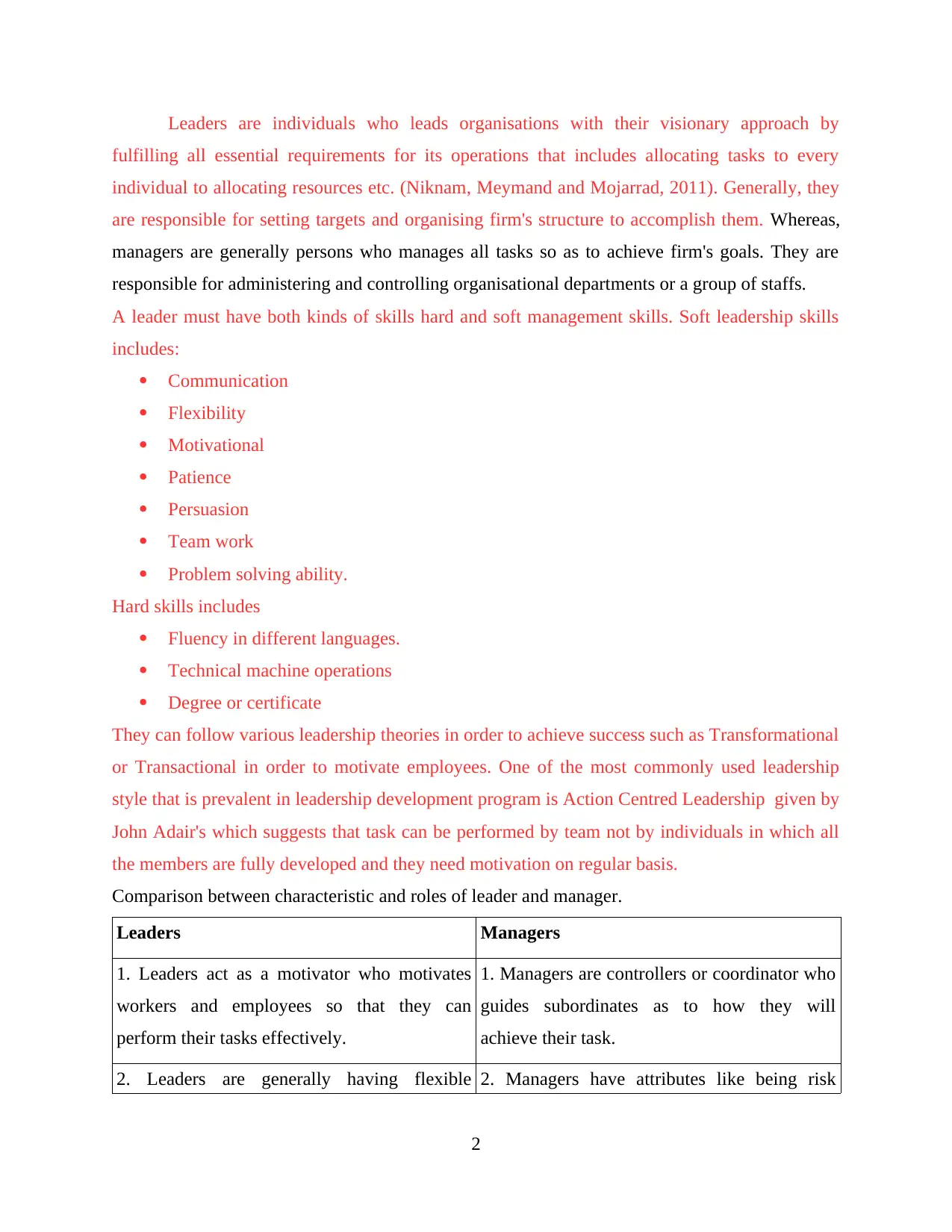
Leaders are individuals who leads organisations with their visionary approach by
fulfilling all essential requirements for its operations that includes allocating tasks to every
individual to allocating resources etc. (Niknam, Meymand and Mojarrad, 2011). Generally, they
are responsible for setting targets and organising firm's structure to accomplish them. Whereas,
managers are generally persons who manages all tasks so as to achieve firm's goals. They are
responsible for administering and controlling organisational departments or a group of staffs.
A leader must have both kinds of skills hard and soft management skills. Soft leadership skills
includes:
Communication
Flexibility
Motivational
Patience
Persuasion
Team work
Problem solving ability.
Hard skills includes
Fluency in different languages.
Technical machine operations
Degree or certificate
They can follow various leadership theories in order to achieve success such as Transformational
or Transactional in order to motivate employees. One of the most commonly used leadership
style that is prevalent in leadership development program is Action Centred Leadership given by
John Adair's which suggests that task can be performed by team not by individuals in which all
the members are fully developed and they need motivation on regular basis.
Comparison between characteristic and roles of leader and manager.
Leaders Managers
1. Leaders act as a motivator who motivates
workers and employees so that they can
perform their tasks effectively.
1. Managers are controllers or coordinator who
guides subordinates as to how they will
achieve their task.
2. Leaders are generally having flexible 2. Managers have attributes like being risk
2
fulfilling all essential requirements for its operations that includes allocating tasks to every
individual to allocating resources etc. (Niknam, Meymand and Mojarrad, 2011). Generally, they
are responsible for setting targets and organising firm's structure to accomplish them. Whereas,
managers are generally persons who manages all tasks so as to achieve firm's goals. They are
responsible for administering and controlling organisational departments or a group of staffs.
A leader must have both kinds of skills hard and soft management skills. Soft leadership skills
includes:
Communication
Flexibility
Motivational
Patience
Persuasion
Team work
Problem solving ability.
Hard skills includes
Fluency in different languages.
Technical machine operations
Degree or certificate
They can follow various leadership theories in order to achieve success such as Transformational
or Transactional in order to motivate employees. One of the most commonly used leadership
style that is prevalent in leadership development program is Action Centred Leadership given by
John Adair's which suggests that task can be performed by team not by individuals in which all
the members are fully developed and they need motivation on regular basis.
Comparison between characteristic and roles of leader and manager.
Leaders Managers
1. Leaders act as a motivator who motivates
workers and employees so that they can
perform their tasks effectively.
1. Managers are controllers or coordinator who
guides subordinates as to how they will
achieve their task.
2. Leaders are generally having flexible 2. Managers have attributes like being risk
2
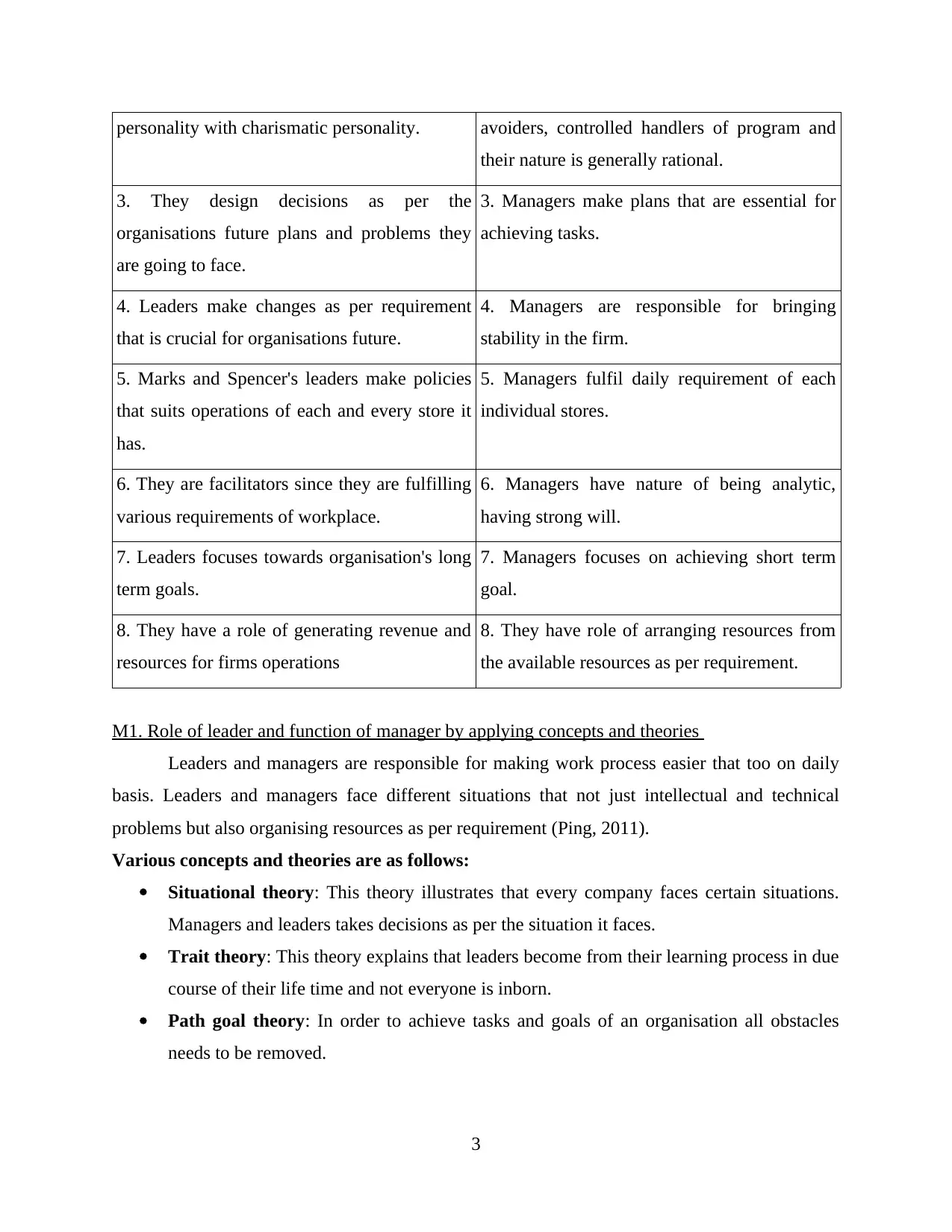
personality with charismatic personality. avoiders, controlled handlers of program and
their nature is generally rational.
3. They design decisions as per the
organisations future plans and problems they
are going to face.
3. Managers make plans that are essential for
achieving tasks.
4. Leaders make changes as per requirement
that is crucial for organisations future.
4. Managers are responsible for bringing
stability in the firm.
5. Marks and Spencer's leaders make policies
that suits operations of each and every store it
has.
5. Managers fulfil daily requirement of each
individual stores.
6. They are facilitators since they are fulfilling
various requirements of workplace.
6. Managers have nature of being analytic,
having strong will.
7. Leaders focuses towards organisation's long
term goals.
7. Managers focuses on achieving short term
goal.
8. They have a role of generating revenue and
resources for firms operations
8. They have role of arranging resources from
the available resources as per requirement.
M1. Role of leader and function of manager by applying concepts and theories
Leaders and managers are responsible for making work process easier that too on daily
basis. Leaders and managers face different situations that not just intellectual and technical
problems but also organising resources as per requirement (Ping, 2011).
Various concepts and theories are as follows:
Situational theory: This theory illustrates that every company faces certain situations.
Managers and leaders takes decisions as per the situation it faces.
Trait theory: This theory explains that leaders become from their learning process in due
course of their life time and not everyone is inborn.
Path goal theory: In order to achieve tasks and goals of an organisation all obstacles
needs to be removed.
3
their nature is generally rational.
3. They design decisions as per the
organisations future plans and problems they
are going to face.
3. Managers make plans that are essential for
achieving tasks.
4. Leaders make changes as per requirement
that is crucial for organisations future.
4. Managers are responsible for bringing
stability in the firm.
5. Marks and Spencer's leaders make policies
that suits operations of each and every store it
has.
5. Managers fulfil daily requirement of each
individual stores.
6. They are facilitators since they are fulfilling
various requirements of workplace.
6. Managers have nature of being analytic,
having strong will.
7. Leaders focuses towards organisation's long
term goals.
7. Managers focuses on achieving short term
goal.
8. They have a role of generating revenue and
resources for firms operations
8. They have role of arranging resources from
the available resources as per requirement.
M1. Role of leader and function of manager by applying concepts and theories
Leaders and managers are responsible for making work process easier that too on daily
basis. Leaders and managers face different situations that not just intellectual and technical
problems but also organising resources as per requirement (Ping, 2011).
Various concepts and theories are as follows:
Situational theory: This theory illustrates that every company faces certain situations.
Managers and leaders takes decisions as per the situation it faces.
Trait theory: This theory explains that leaders become from their learning process in due
course of their life time and not everyone is inborn.
Path goal theory: In order to achieve tasks and goals of an organisation all obstacles
needs to be removed.
3
⊘ This is a preview!⊘
Do you want full access?
Subscribe today to unlock all pages.

Trusted by 1+ million students worldwide
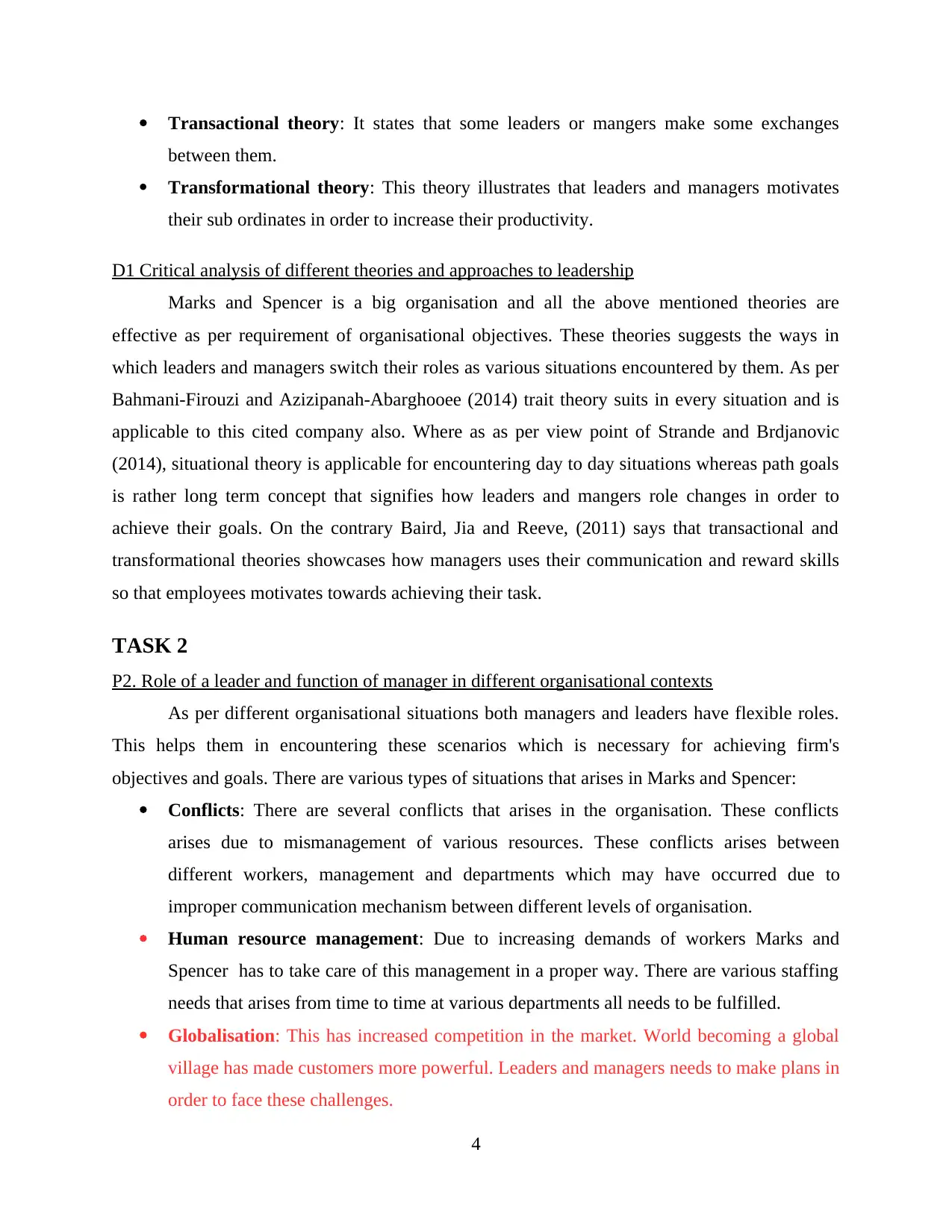
Transactional theory: It states that some leaders or mangers make some exchanges
between them.
Transformational theory: This theory illustrates that leaders and managers motivates
their sub ordinates in order to increase their productivity.
D1 Critical analysis of different theories and approaches to leadership
Marks and Spencer is a big organisation and all the above mentioned theories are
effective as per requirement of organisational objectives. These theories suggests the ways in
which leaders and managers switch their roles as various situations encountered by them. As per
Bahmani-Firouzi and Azizipanah-Abarghooee (2014) trait theory suits in every situation and is
applicable to this cited company also. Where as as per view point of Strande and Brdjanovic
(2014), situational theory is applicable for encountering day to day situations whereas path goals
is rather long term concept that signifies how leaders and mangers role changes in order to
achieve their goals. On the contrary Baird, Jia and Reeve, (2011) says that transactional and
transformational theories showcases how managers uses their communication and reward skills
so that employees motivates towards achieving their task.
TASK 2
P2. Role of a leader and function of manager in different organisational contexts
As per different organisational situations both managers and leaders have flexible roles.
This helps them in encountering these scenarios which is necessary for achieving firm's
objectives and goals. There are various types of situations that arises in Marks and Spencer:
Conflicts: There are several conflicts that arises in the organisation. These conflicts
arises due to mismanagement of various resources. These conflicts arises between
different workers, management and departments which may have occurred due to
improper communication mechanism between different levels of organisation.
Human resource management: Due to increasing demands of workers Marks and
Spencer has to take care of this management in a proper way. There are various staffing
needs that arises from time to time at various departments all needs to be fulfilled.
Globalisation: This has increased competition in the market. World becoming a global
village has made customers more powerful. Leaders and managers needs to make plans in
order to face these challenges.
4
between them.
Transformational theory: This theory illustrates that leaders and managers motivates
their sub ordinates in order to increase their productivity.
D1 Critical analysis of different theories and approaches to leadership
Marks and Spencer is a big organisation and all the above mentioned theories are
effective as per requirement of organisational objectives. These theories suggests the ways in
which leaders and managers switch their roles as various situations encountered by them. As per
Bahmani-Firouzi and Azizipanah-Abarghooee (2014) trait theory suits in every situation and is
applicable to this cited company also. Where as as per view point of Strande and Brdjanovic
(2014), situational theory is applicable for encountering day to day situations whereas path goals
is rather long term concept that signifies how leaders and mangers role changes in order to
achieve their goals. On the contrary Baird, Jia and Reeve, (2011) says that transactional and
transformational theories showcases how managers uses their communication and reward skills
so that employees motivates towards achieving their task.
TASK 2
P2. Role of a leader and function of manager in different organisational contexts
As per different organisational situations both managers and leaders have flexible roles.
This helps them in encountering these scenarios which is necessary for achieving firm's
objectives and goals. There are various types of situations that arises in Marks and Spencer:
Conflicts: There are several conflicts that arises in the organisation. These conflicts
arises due to mismanagement of various resources. These conflicts arises between
different workers, management and departments which may have occurred due to
improper communication mechanism between different levels of organisation.
Human resource management: Due to increasing demands of workers Marks and
Spencer has to take care of this management in a proper way. There are various staffing
needs that arises from time to time at various departments all needs to be fulfilled.
Globalisation: This has increased competition in the market. World becoming a global
village has made customers more powerful. Leaders and managers needs to make plans in
order to face these challenges.
4
Paraphrase This Document
Need a fresh take? Get an instant paraphrase of this document with our AI Paraphraser
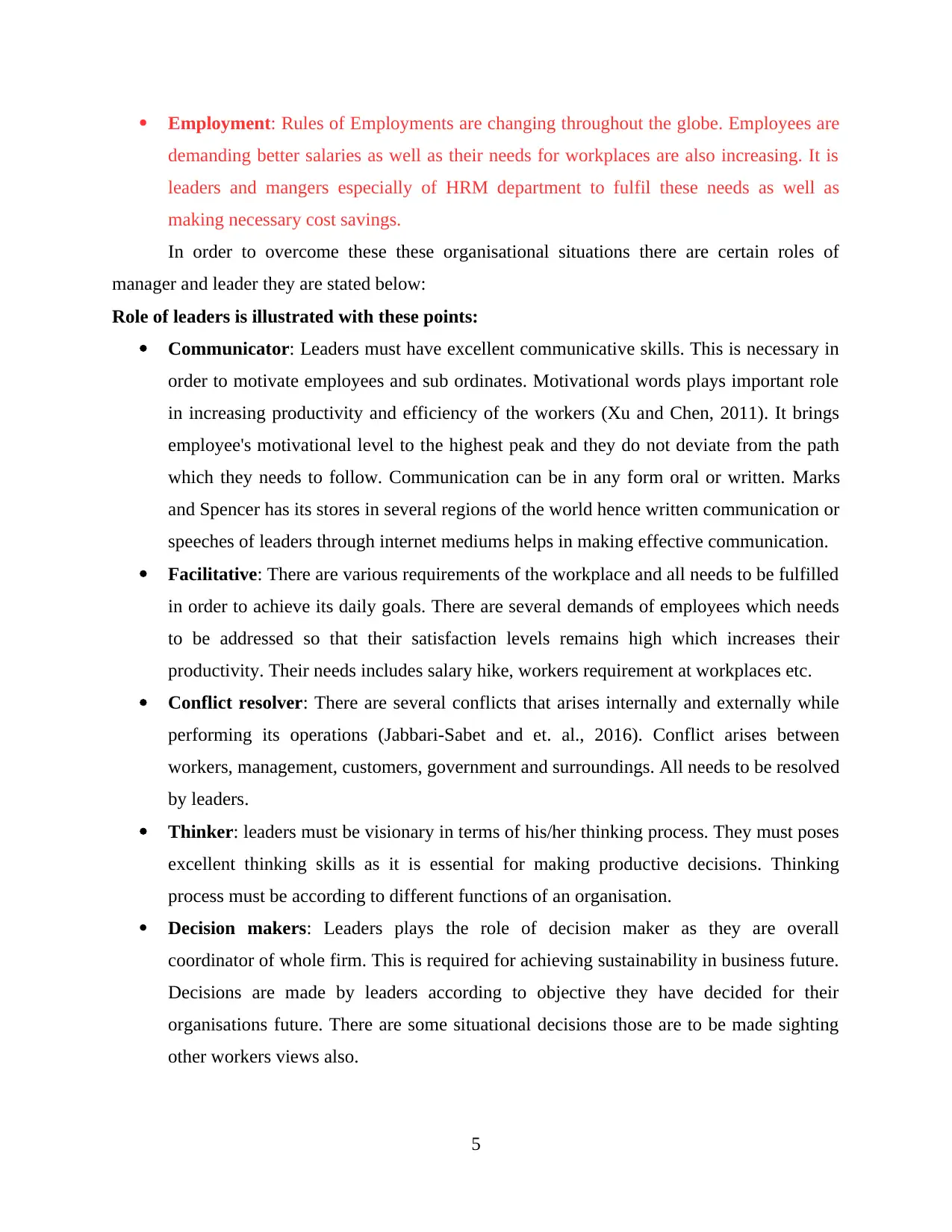
Employment: Rules of Employments are changing throughout the globe. Employees are
demanding better salaries as well as their needs for workplaces are also increasing. It is
leaders and mangers especially of HRM department to fulfil these needs as well as
making necessary cost savings.
In order to overcome these these organisational situations there are certain roles of
manager and leader they are stated below:
Role of leaders is illustrated with these points:
Communicator: Leaders must have excellent communicative skills. This is necessary in
order to motivate employees and sub ordinates. Motivational words plays important role
in increasing productivity and efficiency of the workers (Xu and Chen, 2011). It brings
employee's motivational level to the highest peak and they do not deviate from the path
which they needs to follow. Communication can be in any form oral or written. Marks
and Spencer has its stores in several regions of the world hence written communication or
speeches of leaders through internet mediums helps in making effective communication.
Facilitative: There are various requirements of the workplace and all needs to be fulfilled
in order to achieve its daily goals. There are several demands of employees which needs
to be addressed so that their satisfaction levels remains high which increases their
productivity. Their needs includes salary hike, workers requirement at workplaces etc.
Conflict resolver: There are several conflicts that arises internally and externally while
performing its operations (Jabbari-Sabet and et. al., 2016). Conflict arises between
workers, management, customers, government and surroundings. All needs to be resolved
by leaders.
Thinker: leaders must be visionary in terms of his/her thinking process. They must poses
excellent thinking skills as it is essential for making productive decisions. Thinking
process must be according to different functions of an organisation.
Decision makers: Leaders plays the role of decision maker as they are overall
coordinator of whole firm. This is required for achieving sustainability in business future.
Decisions are made by leaders according to objective they have decided for their
organisations future. There are some situational decisions those are to be made sighting
other workers views also.
5
demanding better salaries as well as their needs for workplaces are also increasing. It is
leaders and mangers especially of HRM department to fulfil these needs as well as
making necessary cost savings.
In order to overcome these these organisational situations there are certain roles of
manager and leader they are stated below:
Role of leaders is illustrated with these points:
Communicator: Leaders must have excellent communicative skills. This is necessary in
order to motivate employees and sub ordinates. Motivational words plays important role
in increasing productivity and efficiency of the workers (Xu and Chen, 2011). It brings
employee's motivational level to the highest peak and they do not deviate from the path
which they needs to follow. Communication can be in any form oral or written. Marks
and Spencer has its stores in several regions of the world hence written communication or
speeches of leaders through internet mediums helps in making effective communication.
Facilitative: There are various requirements of the workplace and all needs to be fulfilled
in order to achieve its daily goals. There are several demands of employees which needs
to be addressed so that their satisfaction levels remains high which increases their
productivity. Their needs includes salary hike, workers requirement at workplaces etc.
Conflict resolver: There are several conflicts that arises internally and externally while
performing its operations (Jabbari-Sabet and et. al., 2016). Conflict arises between
workers, management, customers, government and surroundings. All needs to be resolved
by leaders.
Thinker: leaders must be visionary in terms of his/her thinking process. They must poses
excellent thinking skills as it is essential for making productive decisions. Thinking
process must be according to different functions of an organisation.
Decision makers: Leaders plays the role of decision maker as they are overall
coordinator of whole firm. This is required for achieving sustainability in business future.
Decisions are made by leaders according to objective they have decided for their
organisations future. There are some situational decisions those are to be made sighting
other workers views also.
5
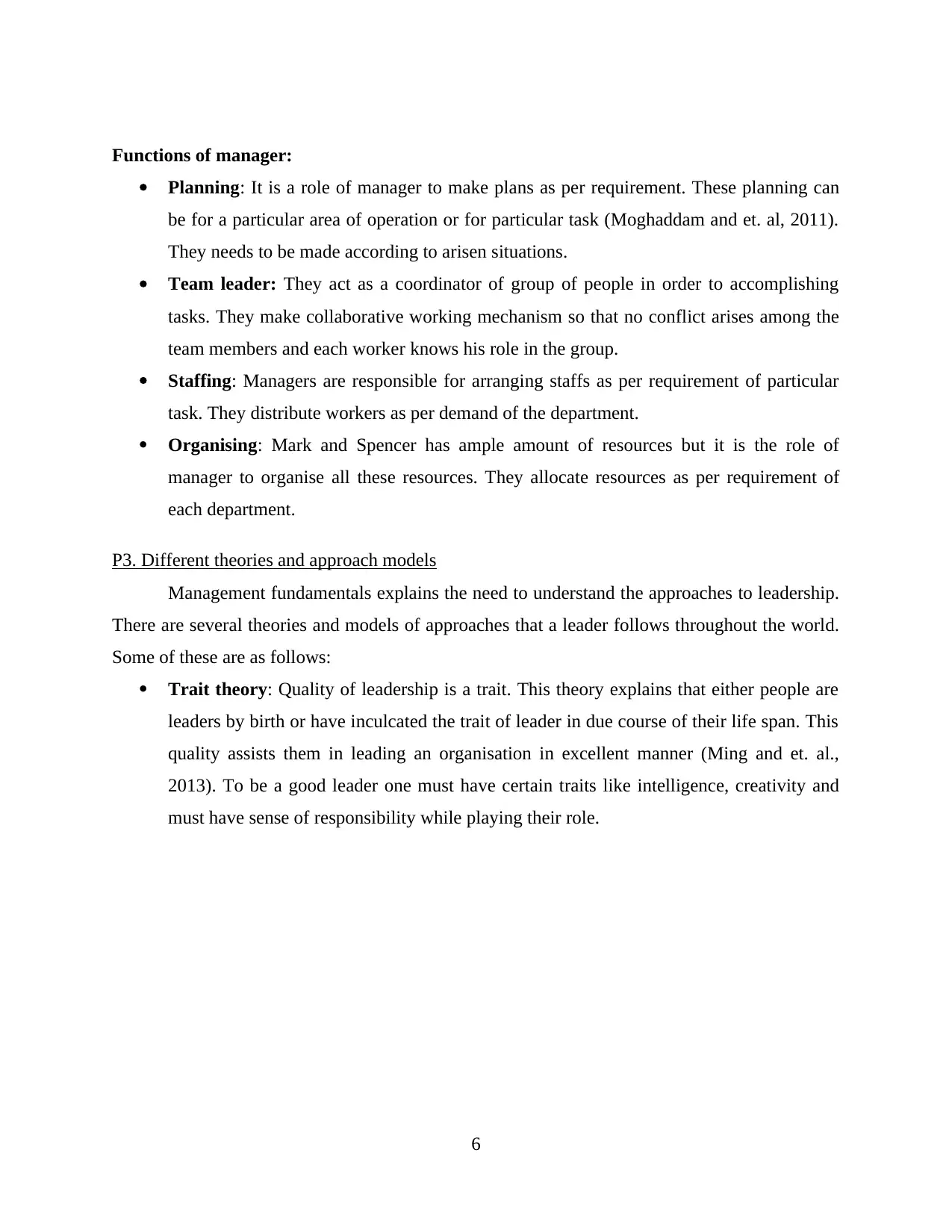
Functions of manager:
Planning: It is a role of manager to make plans as per requirement. These planning can
be for a particular area of operation or for particular task (Moghaddam and et. al, 2011).
They needs to be made according to arisen situations.
Team leader: They act as a coordinator of group of people in order to accomplishing
tasks. They make collaborative working mechanism so that no conflict arises among the
team members and each worker knows his role in the group.
Staffing: Managers are responsible for arranging staffs as per requirement of particular
task. They distribute workers as per demand of the department.
Organising: Mark and Spencer has ample amount of resources but it is the role of
manager to organise all these resources. They allocate resources as per requirement of
each department.
P3. Different theories and approach models
Management fundamentals explains the need to understand the approaches to leadership.
There are several theories and models of approaches that a leader follows throughout the world.
Some of these are as follows:
Trait theory: Quality of leadership is a trait. This theory explains that either people are
leaders by birth or have inculcated the trait of leader in due course of their life span. This
quality assists them in leading an organisation in excellent manner (Ming and et. al.,
2013). To be a good leader one must have certain traits like intelligence, creativity and
must have sense of responsibility while playing their role.
6
Planning: It is a role of manager to make plans as per requirement. These planning can
be for a particular area of operation or for particular task (Moghaddam and et. al, 2011).
They needs to be made according to arisen situations.
Team leader: They act as a coordinator of group of people in order to accomplishing
tasks. They make collaborative working mechanism so that no conflict arises among the
team members and each worker knows his role in the group.
Staffing: Managers are responsible for arranging staffs as per requirement of particular
task. They distribute workers as per demand of the department.
Organising: Mark and Spencer has ample amount of resources but it is the role of
manager to organise all these resources. They allocate resources as per requirement of
each department.
P3. Different theories and approach models
Management fundamentals explains the need to understand the approaches to leadership.
There are several theories and models of approaches that a leader follows throughout the world.
Some of these are as follows:
Trait theory: Quality of leadership is a trait. This theory explains that either people are
leaders by birth or have inculcated the trait of leader in due course of their life span. This
quality assists them in leading an organisation in excellent manner (Ming and et. al.,
2013). To be a good leader one must have certain traits like intelligence, creativity and
must have sense of responsibility while playing their role.
6
⊘ This is a preview!⊘
Do you want full access?
Subscribe today to unlock all pages.

Trusted by 1+ million students worldwide
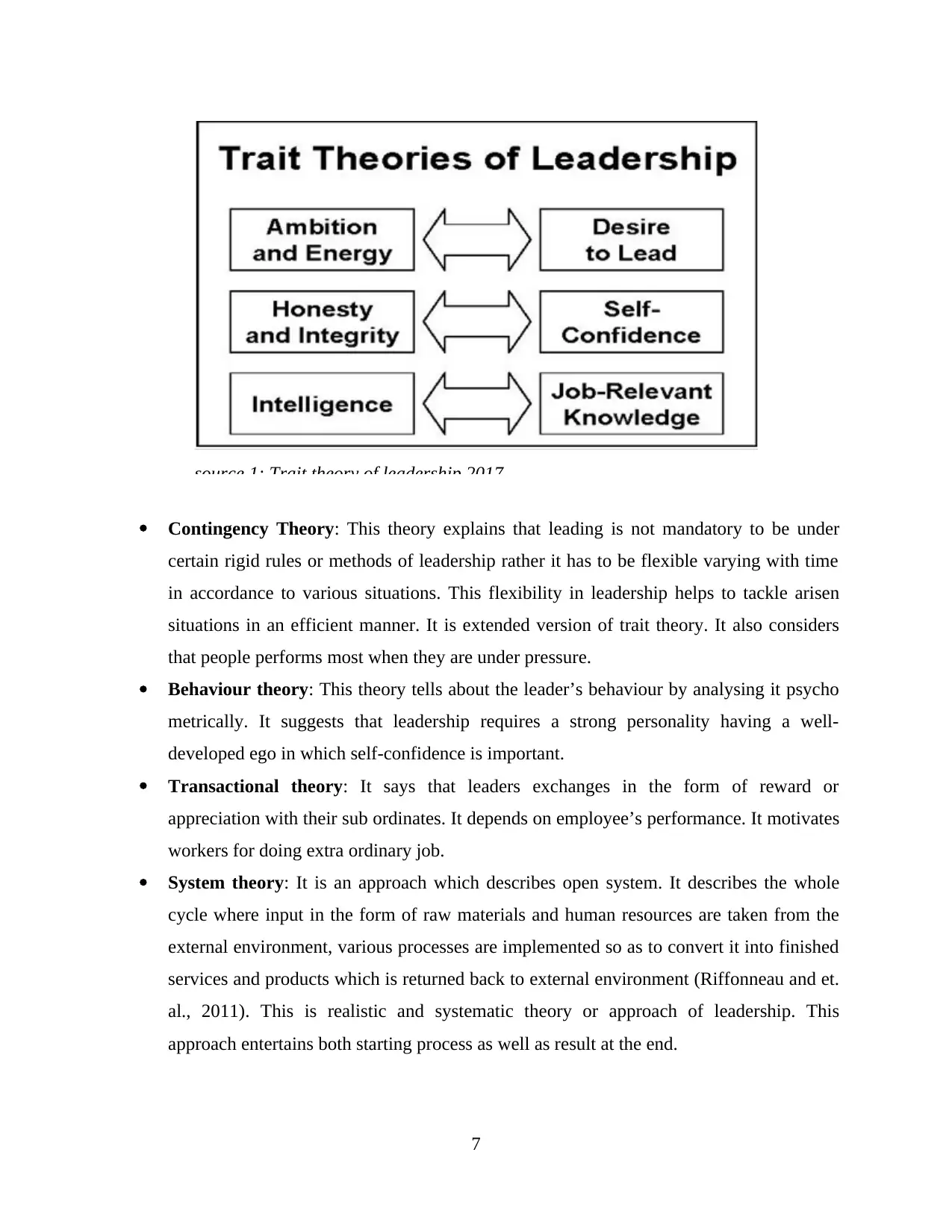
Contingency Theory: This theory explains that leading is not mandatory to be under
certain rigid rules or methods of leadership rather it has to be flexible varying with time
in accordance to various situations. This flexibility in leadership helps to tackle arisen
situations in an efficient manner. It is extended version of trait theory. It also considers
that people performs most when they are under pressure.
Behaviour theory: This theory tells about the leader’s behaviour by analysing it psycho
metrically. It suggests that leadership requires a strong personality having a well-
developed ego in which self-confidence is important.
Transactional theory: It says that leaders exchanges in the form of reward or
appreciation with their sub ordinates. It depends on employee’s performance. It motivates
workers for doing extra ordinary job.
System theory: It is an approach which describes open system. It describes the whole
cycle where input in the form of raw materials and human resources are taken from the
external environment, various processes are implemented so as to convert it into finished
services and products which is returned back to external environment (Riffonneau and et.
al., 2011). This is realistic and systematic theory or approach of leadership. This
approach entertains both starting process as well as result at the end.
7
source 1: Trait theory of leadership 2017
certain rigid rules or methods of leadership rather it has to be flexible varying with time
in accordance to various situations. This flexibility in leadership helps to tackle arisen
situations in an efficient manner. It is extended version of trait theory. It also considers
that people performs most when they are under pressure.
Behaviour theory: This theory tells about the leader’s behaviour by analysing it psycho
metrically. It suggests that leadership requires a strong personality having a well-
developed ego in which self-confidence is important.
Transactional theory: It says that leaders exchanges in the form of reward or
appreciation with their sub ordinates. It depends on employee’s performance. It motivates
workers for doing extra ordinary job.
System theory: It is an approach which describes open system. It describes the whole
cycle where input in the form of raw materials and human resources are taken from the
external environment, various processes are implemented so as to convert it into finished
services and products which is returned back to external environment (Riffonneau and et.
al., 2011). This is realistic and systematic theory or approach of leadership. This
approach entertains both starting process as well as result at the end.
7
source 1: Trait theory of leadership 2017
Paraphrase This Document
Need a fresh take? Get an instant paraphrase of this document with our AI Paraphraser
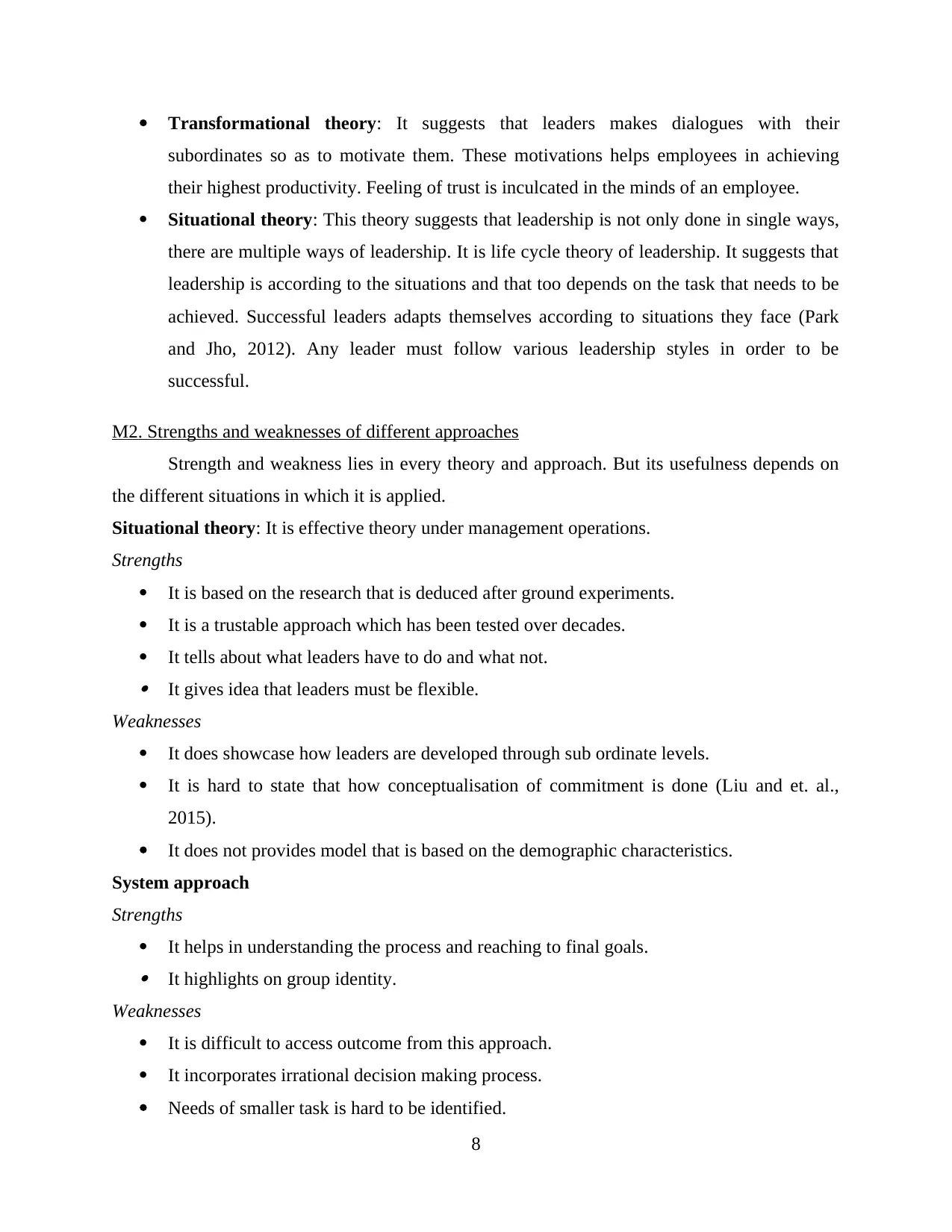
Transformational theory: It suggests that leaders makes dialogues with their
subordinates so as to motivate them. These motivations helps employees in achieving
their highest productivity. Feeling of trust is inculcated in the minds of an employee.
Situational theory: This theory suggests that leadership is not only done in single ways,
there are multiple ways of leadership. It is life cycle theory of leadership. It suggests that
leadership is according to the situations and that too depends on the task that needs to be
achieved. Successful leaders adapts themselves according to situations they face (Park
and Jho, 2012). Any leader must follow various leadership styles in order to be
successful.
M2. Strengths and weaknesses of different approaches
Strength and weakness lies in every theory and approach. But its usefulness depends on
the different situations in which it is applied.
Situational theory: It is effective theory under management operations.
Strengths
It is based on the research that is deduced after ground experiments.
It is a trustable approach which has been tested over decades.
It tells about what leaders have to do and what not. It gives idea that leaders must be flexible.
Weaknesses
It does showcase how leaders are developed through sub ordinate levels.
It is hard to state that how conceptualisation of commitment is done (Liu and et. al.,
2015).
It does not provides model that is based on the demographic characteristics.
System approach
Strengths
It helps in understanding the process and reaching to final goals. It highlights on group identity.
Weaknesses
It is difficult to access outcome from this approach.
It incorporates irrational decision making process.
Needs of smaller task is hard to be identified.
8
subordinates so as to motivate them. These motivations helps employees in achieving
their highest productivity. Feeling of trust is inculcated in the minds of an employee.
Situational theory: This theory suggests that leadership is not only done in single ways,
there are multiple ways of leadership. It is life cycle theory of leadership. It suggests that
leadership is according to the situations and that too depends on the task that needs to be
achieved. Successful leaders adapts themselves according to situations they face (Park
and Jho, 2012). Any leader must follow various leadership styles in order to be
successful.
M2. Strengths and weaknesses of different approaches
Strength and weakness lies in every theory and approach. But its usefulness depends on
the different situations in which it is applied.
Situational theory: It is effective theory under management operations.
Strengths
It is based on the research that is deduced after ground experiments.
It is a trustable approach which has been tested over decades.
It tells about what leaders have to do and what not. It gives idea that leaders must be flexible.
Weaknesses
It does showcase how leaders are developed through sub ordinate levels.
It is hard to state that how conceptualisation of commitment is done (Liu and et. al.,
2015).
It does not provides model that is based on the demographic characteristics.
System approach
Strengths
It helps in understanding the process and reaching to final goals. It highlights on group identity.
Weaknesses
It is difficult to access outcome from this approach.
It incorporates irrational decision making process.
Needs of smaller task is hard to be identified.
8
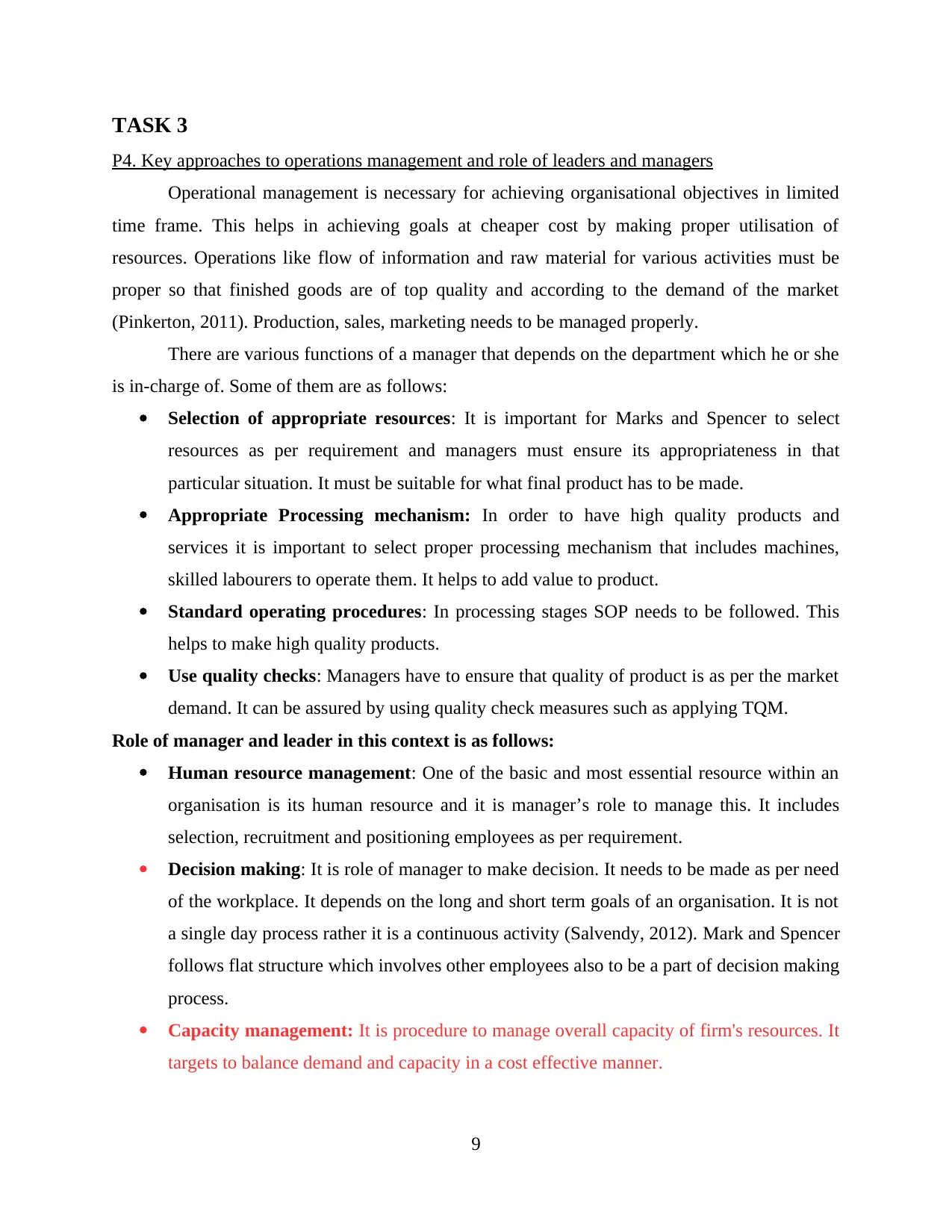
TASK 3
P4. Key approaches to operations management and role of leaders and managers
Operational management is necessary for achieving organisational objectives in limited
time frame. This helps in achieving goals at cheaper cost by making proper utilisation of
resources. Operations like flow of information and raw material for various activities must be
proper so that finished goods are of top quality and according to the demand of the market
(Pinkerton, 2011). Production, sales, marketing needs to be managed properly.
There are various functions of a manager that depends on the department which he or she
is in-charge of. Some of them are as follows:
Selection of appropriate resources: It is important for Marks and Spencer to select
resources as per requirement and managers must ensure its appropriateness in that
particular situation. It must be suitable for what final product has to be made.
Appropriate Processing mechanism: In order to have high quality products and
services it is important to select proper processing mechanism that includes machines,
skilled labourers to operate them. It helps to add value to product.
Standard operating procedures: In processing stages SOP needs to be followed. This
helps to make high quality products.
Use quality checks: Managers have to ensure that quality of product is as per the market
demand. It can be assured by using quality check measures such as applying TQM.
Role of manager and leader in this context is as follows:
Human resource management: One of the basic and most essential resource within an
organisation is its human resource and it is manager’s role to manage this. It includes
selection, recruitment and positioning employees as per requirement.
Decision making: It is role of manager to make decision. It needs to be made as per need
of the workplace. It depends on the long and short term goals of an organisation. It is not
a single day process rather it is a continuous activity (Salvendy, 2012). Mark and Spencer
follows flat structure which involves other employees also to be a part of decision making
process.
Capacity management: It is procedure to manage overall capacity of firm's resources. It
targets to balance demand and capacity in a cost effective manner.
9
P4. Key approaches to operations management and role of leaders and managers
Operational management is necessary for achieving organisational objectives in limited
time frame. This helps in achieving goals at cheaper cost by making proper utilisation of
resources. Operations like flow of information and raw material for various activities must be
proper so that finished goods are of top quality and according to the demand of the market
(Pinkerton, 2011). Production, sales, marketing needs to be managed properly.
There are various functions of a manager that depends on the department which he or she
is in-charge of. Some of them are as follows:
Selection of appropriate resources: It is important for Marks and Spencer to select
resources as per requirement and managers must ensure its appropriateness in that
particular situation. It must be suitable for what final product has to be made.
Appropriate Processing mechanism: In order to have high quality products and
services it is important to select proper processing mechanism that includes machines,
skilled labourers to operate them. It helps to add value to product.
Standard operating procedures: In processing stages SOP needs to be followed. This
helps to make high quality products.
Use quality checks: Managers have to ensure that quality of product is as per the market
demand. It can be assured by using quality check measures such as applying TQM.
Role of manager and leader in this context is as follows:
Human resource management: One of the basic and most essential resource within an
organisation is its human resource and it is manager’s role to manage this. It includes
selection, recruitment and positioning employees as per requirement.
Decision making: It is role of manager to make decision. It needs to be made as per need
of the workplace. It depends on the long and short term goals of an organisation. It is not
a single day process rather it is a continuous activity (Salvendy, 2012). Mark and Spencer
follows flat structure which involves other employees also to be a part of decision making
process.
Capacity management: It is procedure to manage overall capacity of firm's resources. It
targets to balance demand and capacity in a cost effective manner.
9
⊘ This is a preview!⊘
Do you want full access?
Subscribe today to unlock all pages.

Trusted by 1+ million students worldwide
1 out of 20
Related Documents
Your All-in-One AI-Powered Toolkit for Academic Success.
+13062052269
info@desklib.com
Available 24*7 on WhatsApp / Email
![[object Object]](/_next/static/media/star-bottom.7253800d.svg)
Unlock your academic potential
Copyright © 2020–2025 A2Z Services. All Rights Reserved. Developed and managed by ZUCOL.





